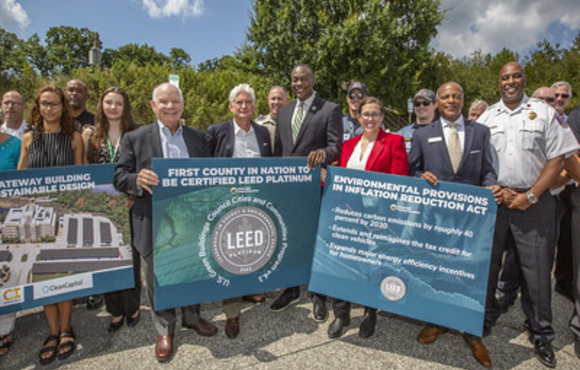This recognition is an acknowledgement of efforts we have undertaken to become the most sustainable community in the nation, such as dedicating ourselves to solar power, transit and electric vehicles, and building infrastructure to make walking and bike-riding easier. We have held ourselves accountable; we have a road map for moving forward. And we will continue to identify new places to lead and to make positive change for all.
Howard County Executive Calvin Ball was joined by U.S. Senator Ben Cardin for the announcement. Cardin noted that Howard County has demonstrated that it is well-positioned to leverage important components of the Inflation Reduction Act signed into law this year, including credits for electric vehicles and funding for green jobs and environmental justice.
“Howard County’s dedication to environmental progress is remarkable, and I have fought hard to deliver several major pieces of recently passed legislation at the national level so that counties across Maryland can continue to make similarly significant strides toward their sustainability goals,” said Cardin, chair of the Subcommittee of Transportation and Infrastructure. “The recent Inflation Reduction Act includes major incentives for homeowners to expand their use of renewable energy sources, re-envisioned the EV tax credit, and will reduce U.S. carbon emissions 40 percent by 2030. This historic investment sets our country on the right path for years to come.”
LEED for Cities and Communities helps local leaders create and operationalize responsible, sustainable and specific plans for energy, water, waste, transportation and many other factors that contribute to quality of life. The LEED framework encompasses social, economic and environmental performance indicators and strategies with a clear, data-driven means of benchmarking and communicating progress.
“The work of cities and communities such as Howard County is a driving force in ensuring a more sustainable future for all,” said Peter Templeton, interim president and CEO, USGBC. “Local governments that achieve LEED certification are lowering carbon emissions, creating a healthier environment and striving to improve the quality of life for their residents. Howard County is setting a standard for what it means to be a high performer and their efforts and achievements should be an example for all.”
Points were awarded in nine categories: energy and greenhouse gas emissions, water efficiency, materials and resources, innovation, natural systems and ecology, quality of life, regional priority, transportation and land use; and integrative process.
Howard County received 82 points out of 110, the second highest amount ever awarded in LEED version 4.1 for Cities and Communities, which is the current version of the rating system. It is also the first county in the U.S. to receive platinum certification under the rating system.
Howard County received the most points possible in Energy and Greenhouse Gas Emissions Performance (14/14), Innovation (6/6) and Water Performance (6/6), as well as in several other areas.
According to the USGBC, Howard County achieved every credit available in the “quality of life credit” – from civil and human rights and environmental justice to housing affordability and civic, which organization leaders said showed a “a commitment to creating a better community for all residents.”
